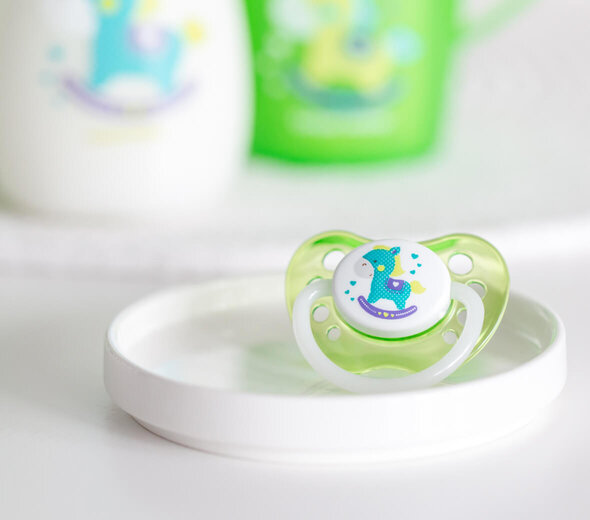

Your baby sucks his mum's breast, thumb, the corner of a blanket. Sucking is one of the strongest instincts a baby comes to the world with. When sucking on something, your baby calms down, falls asleep and feels happy and safe.
Thanks to sucking, a newborn's jaw gradually shifts forward and at the end of his first year, the final, proper outline of the baby's jaw is formed. During his first 2-3 months, your baby mostly eats and sleeps. Sucking instinct is usually sufficiently satisfied through breastfeeding.
Older children, who have longer breaks between feedings as well as longer and longer wake periods, may sometimes additionally need a soother (sometimes parents' decide to give a soother even to a younger child if they notice that his sucking instinct isn't satisfied enough through feeding - some babies need a soother especially during their first three months). Before you choose a soother, check the size, material and shape of the teat.
Choosing the soother size according to the child's age is very important. Using a too small soother might cause bite problems, as the baby will have trouble keeping the soother in his mouth.
There are two different soother age classification systems.
First: children aged 0-3 months, from 3 to 6 months and from 6 to 18 months.
Second (characteristic for soothers made by Canpol Babies): A (from 0 to 6 months, with a small shield and the smallest teat), B for a little older children (up to 18 months) and C for the oldest children (over 18 months). Size C isn't available in all soother types as children this age shouldn't use a soother anymore. The division is, of course, conventional. You know best what kind of soother to choose for your baby and when to substitute it with a bigger one, by observing the development of your child (and as we know all children develop and grow at their own pace).
Teat type - latex teats, made of India-rubber (light brown, transparent or lightly matte), with a characteristic taste and smell. These teats are less durable - the teat loses its elasticity in use, darkens under the influence of sunlight, becomes sticky in longer use and increases its volume. - silicone teats, made of liquid silicone (completely transparent), without taste or smell. Soothers with silicone teats are definitely more durable and resistant, and they are tasteless and odourless (which makes it easier to ween the baby from the soother). They also don't deteriorate under the influence of sunlight.
The disadvantage of silicone teats is that they are slightly less resistant to biting. If your child has already developes teeth and you want to give him a silicone soother, remember to check the soother regularly in order to see if it has been gnawed by your baby. In order to ensure your baby comfort and safety, substitute his soother for a new one at least every 1-2 months. When buying a new soother, remember to buy one with the same kind of teat as the previous soother.
Soothers come in three different shapes.
The most popular one is the orthodontic shape (slightly flattened at the side that touches the child's tongue, and enhanced at the side that touches the palate). There's only one way you can put it into your child's mouth - with the enhanced side up. The shield of such teat has always a special profiling under the child's nose.
Another teat shape - the rounded one - has a teat in the shape of a cherry, that is narrow by the shield and gradually widens and becomes round towards the other end. This kind of teat can be put in your child's mouth any way you want, because its shield has the shape of an 8.
The third type is the symmetrical soother - it has a teat that is flat from both sides. It can be put in the baby's mouth any way you want (it doesn't have a top or bottom side). Its shield has a similar shape than the cherry shaped soothers.
A proper soother should have good ventilation. When you press the teat, the air should come out, and when you release it, the teat should return to its previous shape. Remember not to buy soothers with plastic elements inside the teat or soothers with a very stiff teat which doesn't ventilate properly. Using such soothers has a negative effect on the development of the child's oral cavity.
It's an element not only with a practical, but also a decorative function. Soothers have either traditional shields (with a cutting-out on one side for the baby's nose) or shields in the shape of an 8 (with a cutting-out on both sides). Before buying, check that the shield has ventilation holes.
Remember to choose the shield according to the size of your baby's mouth. If the shield is too small, the baby can suck it into his mouth, whereas if it's too big, it can make it harder for the baby to breathe. Remember also, that some soothers have shields in the shape of a ring. I don't recommend using them, as in most cases the shield presses the baby's nose.
Before buying a soother, check that the handle is smooth and properly attached to the shield. Soothers with a glow-in-the-dark handle (containing fluorescent pigment) are very practical for night-time use (they are easy to find in a dark room). It's usually clearly marked at the package. Glowing handles are completely safe and they fulfill all safety norms. It's best to attach a soother holder to the handle, so that your baby can't drop the soother on the floor.
It also keeps the soother cleaner. You can also buy a soother without a handle, which is good for sleeping - if the baby often wipes his face with his hand during sleep, he can't accidentally grab the handle and pull the soother out of his mouth.
Don't buy a soother if:
- the latex teat has a dark brown colour, it's soft and not very elastic
- there are stiff, plastic elements inside the teat
- the teat is not elastic (you can check it by pulling it hard - it should not break)
- the teat has hard or uneven spots - the teat does not have the producer's mark on it (e.g. all soothers made by Canpol Babies have a NG sign on their teats)
- it doesn't have a cutting-out for the baby's nose
- the surface of the teat is rough and uneven
- the teat doesn't have ventilation holes
- the handle isn't properly attached to the shield (your baby could take it off and put it into his mouth)